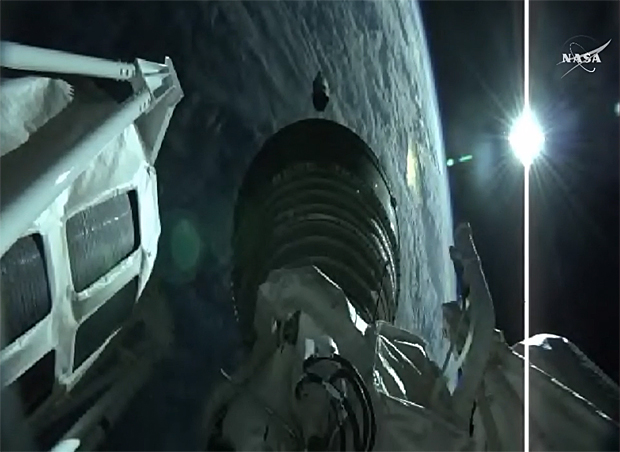Fourth time's the charm for space station cargo launch
After three back-to-back weather delays, a United Launch Alliance Atlas 5 rocket finally boosted an Orbital ATK Cygnus cargo ship into orbit Sunday on a flight to deliver nearly 4,700 pounds of critical supplies and equipment to the International Space Station.
The Atlas 5's powerful Russian-built RD-180 engine ignited with a rush of brilliant exhaust at 4:44:57 p.m. EST (GMT-5), throttled up to full power and majestically pushed the 19-story-tall rocket away from pad 41 at the Cape Canaveral Air Force Station.
Propelled skyward by more than 860,000 pounds of thrust, the rocket initially climbed straight up, knifed through a deck of low clouds and arced over on a northeasterly trajectory into the plane of the space station's orbit, quickly disappearing from view as it began a three-day rendezvous.
Launch tries Thursday, Friday and Saturday were scrubbed due to thick clouds, rain and high winds, but conditions improved over the weekend and despite late-afternoon clouds and gusting winds, mission managers were finally able to clear the rocket for launch.
Liftoff came a little more than one year after an Orbital Antares rocket exploded seconds after launch that destroyed a Cygnus cargo ship in a major setback for NASA and Orbital ATK.
But using the first of two stop-gap Atlas 5s purchased from ULA by Orbital to help make up for the failure, Sunday's launching went smoothly and the RD-180 chalked up another flawless performance, the Russian engine's 66th in a row, boosting the spacecraft out of the dense lower atmosphere.
The rocket's Centaur second stage's Aerojet Rocketdyne RL10C engine then finished the job, propelling the Cygnus cargo ship into orbit 18 minutes after liftoff.
"This is about as good as it gets," said Verne Thorp, who manages NASA missions for ULA. "I know the crew up on the ISS is really looking forward to getting this cargo."
ULA CEO Tory Bruno tweeted: "ISS, Santa is on his way!"
And a few minutes after that, station commander Scott Kelly, who is spending nearly a year aboard the lab complex along with cosmonaut Mikhail Kornienko, sent down a photo showing the Atlas 5's expanding exhaust plume as it climbed toward orbit behind the station.
"Caught something good on the horizon," Kelly tweeted. "Cygnus at sunset on its way to space station!"
Making its fourth operational flight to the station, the Cygnus is the first "enhanced" version featuring more storage volume and improved solar arrays, which unfurled as planned about an hour after launch.
"We had a perfect orbit injection, really right on the money," said Frank DeMauro, Orbital vice president of human space systems. "The big task we wanted to see get complete before we declared full health was the solar array deployment. This is the first time we deployed our new UltraFlex array, and ... everything was perfect."
If all goes well, the spacecraft will reach the station early Wednesday, pulling up to within about 30 feet and then standing by while astronaut Kjell Lindgren, operating the lab's robot arm, snares a grapple fixture around 6:10 a.m. The freighter will then be pulled in for berthing at the central Unity module's Earth-facing port.
On board: nearly 7,400 pounds of supplies and equipment, including 192 pounds of computer gear, 2,600 pounds of crew clothing, food, Christmas presents and other supplies, 500 pounds of spacewalk equipment, including a refurbished spacesuit and emergency jetpack.
While no perishable food or fresh fruit is on board, "some of the bags are crew care packages, so I anticipate there are probably some Christmas presents on there from their families and other kind of special treats for them," said Dan Tani, a former NASA astronaut and station veteran who now manages Orbital's cargo operations. "But the majority of it is provisions that they need, science equipment, spare parts, that kind of thing."
The Cygnus is loaded with 2,220 pounds of station hardware and spare parts, including high-pressure oxygen and nitrogen tanks for the lab's air system, and 1,867 pounds of research gear, including a portable 3D printer, a new life sciences facility, materials science equipment and a microsatellite launcher and payload.
Also on board: a small camera-equipped "Cubesat" assembled by elementary students at the St. Thomas More Cathedral School of Arlington, Virginia, that will be launched later from the space station. If all goes well, the camera will beam down slow-scan video images of Earth to a ham radio receiver at the school's "mission control" center.
Orbital's Antares/Cygnus cargo vehicle is one of two space station resupply systems funded by NASA via commercial contracts to make up for the lost capability of the now-retired space shuttle.
Space Exploration Technologies, or SpaceX, won an initial $1.6 billion contract for at least 12 missions to deliver 20 tons of cargo to the station using the company's Falcon 9 rockets and Dragon cargo ships. Orbital holds a $1.9 billion contract to deliver a similar amount.
But both companies have suffered launch failures that, combined with a Russian Progress, resupply failure in April, deeply cut into the space station's on-board reserves of food, toilet supplies, spare parts and other critical gear stored on board to protect against launch failures.
Station program manager Kirk Shireman said last week the lab currently has enough food to last until April even if no other cargo ships show up. But another Progress is scheduled for launch Dec. 21 and SpaceX plans to resume station delivery flights in January, its first since a spectacular June failure.
Even so, Shireman said, it could take until the end of next year to completely recover from the launch failures.
"As you know, 2015 has been a difficult year for ISS," he said. "But we're still in good shape with consumables. We have basically toilet supplies through February of next year and food, we hit our warning line, if you will, Feb. 19. Right now, our projections are we'd be out of food on April 12. So we're looking forward to having those supplies replenished on board Cygnus."
Orbital launched three successful resupply flights in 2013 and 2014 before one of the company's Antares boosters exploded in a spectacular fireball 15 seconds after launch Oct. 28, 2014, from the Mid-Atlantic Regional Spaceport at NASA's Wallops Island, Va., flight facility.
More than 5,000 pounds of cargo and supplies, including research hardware, student experiments, spare parts, food and crew supplies, 32 small nanosatellites and other gear, were lost in the mishap.
The cause of the failure was narrowed down to the liquid oxygen pump on one of the Antares booster's two AJ26 engines. While a single root cause could not be identified, investigators concluded any one of three possible failures -- foreign object debris in the pump, a fragile bearing housing or a manufacturing defect -- could have triggered the disaster.
In the wake of the failure, Orbital, which later merged with solid-fuel rocket maker ATK, discarded the 1970s-vintage Russian-built AJ26 engines and began work to modify the Antares to fly on state-of-the-art Russian RD-181 engines. To return to flight as quickly as possible, the company bought two Atlas 5s from ULA.
But the Orbital, Progress and SpaceX failures cost the space station more than seven tons of needed supplies, equipment and spare parts. To put those losses in context, Tani said more than 33,000 pounds of supplies are required each year to support a full-time crew of six aboard the space station.
"The crew of six are working the majority of their time on science, that's why we designed the space station," he said. "We are sending up lots of spare parts. Think of the space station as a very complicated Winnebago and you can't stop at Walmart and Pep Boys. So everything you're going to need, for you and the vehicle, has to be up there pre-positioned."
And with a crew of six, "you have to send a lot of crew provisions," he said. "For example, 6,000 meals have to go up every year. Stuff like 500 pairs of socks. When you think of keeping six people alive and healthy for their stay on orbit, that's quite a bit of stuff you have to send up."


